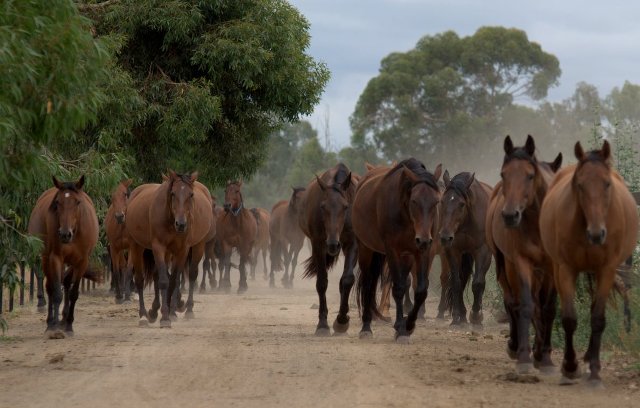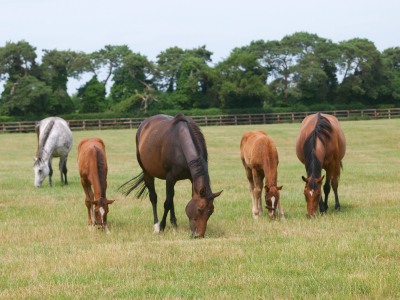 For many, the decision to perform embryo transfer (ET) from a valuable donor mare must also consider the location and availability of quality and reputable recipient mare herds. In certain parts of the country, the availability of recipient herds with fertile, healthy, manageable, and adequate recipient numbers is very limited. In other parts of the country, quality recipient herds are easily found and used successfully for both fresh and shipped embryos. Picking the right recipient herd for your donor mare should always involve carefully reading the recipient contract and knowing what is expected from the donor mare, recipient mare lease, return policy, lost embryo/fetus policy, and enrollment fee requirements. The ins-and-outs of recipient lease or purchase agreements are great topics to be covered in a later blog article. However, when it comes to selecting a recipient herd to ship your donor mare, ship a collected embryo, or trailer the donor mare into a facility for an embryo flush attempt, it is important to know what we as ET practitioners are looking for in recipient mares.
For many, the decision to perform embryo transfer (ET) from a valuable donor mare must also consider the location and availability of quality and reputable recipient mare herds. In certain parts of the country, the availability of recipient herds with fertile, healthy, manageable, and adequate recipient numbers is very limited. In other parts of the country, quality recipient herds are easily found and used successfully for both fresh and shipped embryos. Picking the right recipient herd for your donor mare should always involve carefully reading the recipient contract and knowing what is expected from the donor mare, recipient mare lease, return policy, lost embryo/fetus policy, and enrollment fee requirements. The ins-and-outs of recipient lease or purchase agreements are great topics to be covered in a later blog article. However, when it comes to selecting a recipient herd to ship your donor mare, ship a collected embryo, or trailer the donor mare into a facility for an embryo flush attempt, it is important to know what we as ET practitioners are looking for in recipient mares.
A standard response as to what makes the perfect recipient is as follows… “4-12 years old, has had a foal in the past, normal delivery, reproductively and musculoskeletal soundness, good mothering, large frame, and easy to catch at pasture.” Included in this list is the caveat that she hasn't been actively bred and unable to become pregnant during her lifespan. Various breeds and sizes are a necessity so that recipient mares are available to match the size and frame of multiple breeds of donor mares. So, break that down into components and you’ll see a checklist of nine or ten possible characteristics to look for in recipients. Do any recipients make the list for all ten points? The answer is yes, and if they do, we make darn sure they foal out without issue and are returned to us in good health to continue their career as fertile recipient mares.
When it comes to picking a recipient herd, there are 5 key questions to ask the provider. Embryo transfer (ET) practitioners should be able to answer these questions with little hesitation and provide documentation as needed.
- Is there a written and documented herd health protocol?
- What are the transfer success rates and pregnancy rates in recipients past day 35 of pregnancy?
- What will it cost? Easily understandable fee schedules including any enrollment fees, recipient return fees, purchase or lease costs, and responsibility for recipient mare health
- What occurs if a pregnancy is lost? Is there a live-foal guarantee or credit for future services provided?
- How is the recipient mare herd managed?
 Breaking those five questions into parts, it is easy to determine what recipient facility works for your donor mare and farm goals. The first three questions simply show proper documentation and due diligence of the ET practitioner to know how they care for their mares, how they monitor their success rate, and the knowledge of both parties of the fees associated with equine ET. The last two questions, points 4 and 5 are a little more complex. With regards to the loss of a pregnancy after the recipient has left the ET facility, practitioners either offer a “live foal-guarantee” where the cost of the recipient lease is either refunded or there is a credit applied to future ET services if the recipient mare loses the pregnancy after a certain day of gestation. One point to keep in mind is that everything in ET is referenced in time from the donor mare’s ovulation. So a flush that occurs on “day 7” is occurring seven days from the donor mares ovulation date. When that gets confusing is when we place that 7-day pregnancy into a recipient mare that has ovulated only 5-7 days prior to the flush. What the means is that an embryo that is seven days old, is transferred into a recipient who maybe only five days from her ovulation. That recipient mare is now considered to be seven days in foal, and assumes the gestational age of the embryo implanted in her. Knowing the way embryos and pregnancies are defined is critical to understanding the language and conditions set forth in recipient mare lease agreements.
Breaking those five questions into parts, it is easy to determine what recipient facility works for your donor mare and farm goals. The first three questions simply show proper documentation and due diligence of the ET practitioner to know how they care for their mares, how they monitor their success rate, and the knowledge of both parties of the fees associated with equine ET. The last two questions, points 4 and 5 are a little more complex. With regards to the loss of a pregnancy after the recipient has left the ET facility, practitioners either offer a “live foal-guarantee” where the cost of the recipient lease is either refunded or there is a credit applied to future ET services if the recipient mare loses the pregnancy after a certain day of gestation. One point to keep in mind is that everything in ET is referenced in time from the donor mare’s ovulation. So a flush that occurs on “day 7” is occurring seven days from the donor mares ovulation date. When that gets confusing is when we place that 7-day pregnancy into a recipient mare that has ovulated only 5-7 days prior to the flush. What the means is that an embryo that is seven days old, is transferred into a recipient who maybe only five days from her ovulation. That recipient mare is now considered to be seven days in foal, and assumes the gestational age of the embryo implanted in her. Knowing the way embryos and pregnancies are defined is critical to understanding the language and conditions set forth in recipient mare lease agreements.
The single largest determinant for picking a recipient herd should be the manner in which the herd is managed. Certain herds with say 500 or more mares follow groups of recipient mares at a time and when they ovulate, either naturally or induced with hCG or Deslorelin, then become eligible for any embryo that is recovered in a single day. As that cohort of recipients become pregnant with donor embryos, more mares are added to the ‘working stock’ of mares that are being followed for dates of ovulation. A more common approach for herds with say less than 50 mares is to follow the entire herd and as donor mares ovulate, choosing two or three appropriate recipient mares to induce to ovulate so that they line up with a particular donor mare. For instance, a practice with a donor Friesian mare can set up two or more larger framed draft mares or draft crosses to be eligible to receive the donated embryo. This method can allow for more custom alignment of donor and recipient size and synchronization. It does, however, require extra effort on the part of the recipient manager to choose correctly the recipients for a particular donor mare.
 One statement that drives ET practitioners crazy is the mentality that “Oh, it’s just a recip.” The mentality that we have these large herds of horses that get minimal care, minimal forage, and poor husbandry is often quite unfounded. It is very often just the opposite for veterinarians that manage recipient mares. ET veterinarians spend a large portion of each day, feeding, vaccinating, monitoring estrus cycles, treating everyday illness, and managing the health of the herd as a whole. I walk with and check our recipient herd daily to make sure the herd, and the individuals, are well cared for. I view the recipient mares that I send home pregnant with a donated embryo as a direct reflection of our ability to be good stewards of the horse and our ability to provide long term care for recipient mares that maybe in our care for upwards of a decade.
One statement that drives ET practitioners crazy is the mentality that “Oh, it’s just a recip.” The mentality that we have these large herds of horses that get minimal care, minimal forage, and poor husbandry is often quite unfounded. It is very often just the opposite for veterinarians that manage recipient mares. ET veterinarians spend a large portion of each day, feeding, vaccinating, monitoring estrus cycles, treating everyday illness, and managing the health of the herd as a whole. I walk with and check our recipient herd daily to make sure the herd, and the individuals, are well cared for. I view the recipient mares that I send home pregnant with a donated embryo as a direct reflection of our ability to be good stewards of the horse and our ability to provide long term care for recipient mares that maybe in our care for upwards of a decade.
And that brings me to my last point. ET practitioners should offer recipient leases, not recipient sales. As providers of quality recipients, we spend an exorbitant amount of time prepping, feeding, managing, and caring for the mares in our herds. Therefore, it is odd to not want a quality recipient returned. Most practices insist on the timely return of a recipient mare, and charge a large fee if the mare is not returned. And we do so for good cause. A good recipient mare one year makes for a good recipient mare a second year, and a third year, etc. Choosing a recipient herd may ultimately come down to ease of access and location relative to the donor mare. But not all facilities offer the same services, same contractual requirements, or same quality of recipient mares. As a potential client it is important to ask the right questions of a recipient facility to make sure that you are bringing home a healthy, safe, fertile, and well cared for recipient mare.
See also:
Embryo Transfer and Frequently Asked Questions


Log in to join the conversation.